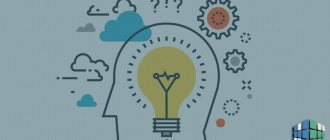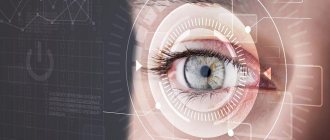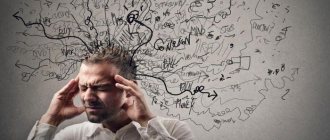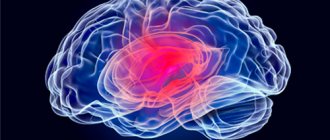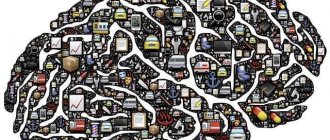A huge number of people live and work in “Groundhog Day”. Now they make money, but later they will turn into old people with progressive dementia. It's a shame, but what can you do? Nothing accelerates brain atrophy more than routine and a constant environment. It destroys the attention system, weakens memory, and disables the “pleasure center.”
The good news is that the brain is plastic and trainable. Elizabeth Gould and Bruce McEwan conducted several experiments with monkeys - scientists found that animals form new neural connections when they perform actions that are unusual for them. The women made a statement that the phenomenon being studied is also characteristic of humans. Mostly neurons are added to the medial surface of the temporal lobe, which is responsible for memory, naming, taste, smell, and sound synthesis. New neurons were also noticed in the prefrontal and inferior parietal zones: the first carries out complex control of mental and motor activity, the second forms articulatory actions.
Neurons are a small universe
As you can see, neurons are formed in areas that affect critical cognitive functions. These are the ones that need to be developed so as not to accidentally hand over your apartment to scammers when you are well over 90. It is important to develop a training program that will involve all functions at the same time or one by one.
I went through the blogs of psychotherapists, read books about brain plasticity, remembered several exercises from speed reading courses and compiled a selection of cognitive exercises. Do they work? We'll find out in old age. If you have already exercised and feel qualitative changes, write in the comments which ones.
Go!
Everyday exercises to develop cognitive abilities
These exercises can be done without interruption from the natural course of life, adding new, sometimes piquant conditions. They train terrain orientation, balance, all types of perception and, as a bonus, increase memory capacity.
- Designate a day of darkness: shower, eat, clean without light.
- Watch videos without images or with images but no sound.
- If there is a child, check his homework (+1000 stamina).
- Give each video you watch a title. Summarize the whole meaning in one word. Come up with names for the shops and establishments you walk near. Don't repeat yourself.
- Navigate around the city without a map, invent unfamiliar routes.
Emergence of the cognitive approach
There is disagreement as to who founded the cognitive approach. Some sources date the term, mentioned in Ulric Neisser's book Cognitive Psychology, to the 1960s.
The book draws an analogy between the work of mental processes and the work of computer programs. This is partly due to dissatisfaction with the behavioral approach, which focuses on external behavior without understanding the internal processes that give rise to it. The cognitive approach in psychology is based on the principle that behavior is generated by a series of stimuli and reactions to them by thought processes.
Balance and coordination exercises
Balance and coordination exercises improve blood flow to all parts of the brain. Accordingly, more oxygen enters the main organ, which stimulates cellular respiration and slows down the process of cell death.
- Stand up straight, arms extended with fingers spread. Connect them so that your fingers match. After a second, separate and place your hands on your shoulders (right to right, left to left). Connect your fingers again. Repeat the exercise 10–20 times at a fast pace and with a minimum of misses when connecting your fingers
Put your fingers together
- Sit down and stretch your legs crossed at the ankles so that your feet touch the floor. Slowly bend forward as you exhale. Extend your arms parallel to your legs. Return to the starting position while inhaling. Repeat 4-6 times.
- Lie down. Bend your lower leg and bring your upper arm to your bent elbow. Do the exercise slowly, being aware of every millimeter of movement.
- Stand straight but relaxed. Alternately tilt your head to the sides and touch your shoulders with your earlobes. Extend your hand forward and imagine that you are holding your index finger at the core of a flower with five petals. Follow the contours of the flower with the upper body.
- Remember what the peace and approx signs look like. Extend either hand and alternately show the signs made from your fingers. Practice for a minute. Then do the same with both hands and at a very fast pace. At the third stage, add sound: say the proverb “There is honey cake, but I have no time for honey cake”
When you achieve synchronization, perform the exercise so that each hand shows a different sign.
Do you want to get a sought-after Internet profession? Sign up for the SMM Specialist course from TexTerra.
Imagination exercises
Imagination distinguishes us from animals. This is what biologists say: seals deny this fact. Develop your imagination to be able to navigate different points of view, experience subconscious experiences, and think creatively.
- Imagine in your head how you play the piano. How are your fingers positioned? At what speed are they moving? What melody is being played - hear the sound, catch the rhythm, try to move to the beat. Think of a story - why this composition was born, what feelings it is associated with. Do the exercise in silence.
- Print out several copies. On each one, complete the picture in accordance with the random theme that arose in your head (animals, body parts, accessories, etc.).
I mentally drew the girl. And you?
- Name associations with the numbers 12, 7, 4, 56, 11. When these numbers run out, come up with new ones and repeat the exercise.
- Look at the picture. Imagine the music with which she is associated. Write down a story that, in terms of dynamics (cheerful, cheerful, sad, etc.) repeats the composition in your head.
Radcliffe as a corpse in The Swiss Army Knife
- Think about the last movie you watched. Transfer the script to another era: how will the plot be transformed, will the characters’ characters change, will the ending be the same?
Exercise to develop taste and olfactory perception
Exercises involve the lower part of the parietal lobe, and also affect the limbic system, which regulates emotions and memory. So in the process of doing it you will get not only new neurons, but also a good mood.
- Come up with and prepare a dish that contains the maximum number of ingredients and which you have not tried.
- Order an unknown dish in a cafe and guess the ingredients: first by the smell, then by the taste. If you like liquid states, order a cocktail and repeat the procedure.
- Go outside and smell objects that you have seen but not smelled: a fence, a sign in a cafe, a kettle in the office. Relate in your head the smells of inanimate nature with already familiar smells of any nature. Then smell the plants, animals, birds. Do this if you are not allergic and you are confident that it is safe to interact with wildlife.
- Give as many definitions of the smells of common things as possible: onions - bitter, pungent, disgusting, etc.
- Compare the smells of objects from the same species group: perfume with perfume, herbs with herbs, cats with cats. How are they different? Find a large number of differences.
Beliefs (attitudes)
Beliefs are a deeper and more stable cognitive phenomenon.
Starting from childhood, people strive to understand the world around them. In order to adapt and organize their experience into a certain system, they look for logical relationships in what is happening to them. Interaction with the world and other people leads to the formation and assimilation of certain conclusions.
This is how people form certain beliefs about themselves, the people around them and the world as a whole. The most important, or deepest beliefs are attitudes that are so deep and fundamental that people often cannot clearly express them, or even simply realize them. The bearer of such ideas regards them as pure truth simply because that is how it “is.” This belief may only affect that person when they are depressed or active most of the time. When this deep view is activated, a person interprets everything that happens to him through the prism of this belief, despite the fact that, from the standpoint of common sense, the corresponding explanations may be frankly erroneous. In this case, a person may tend to take into account only information that confirms his core belief, ignoring or undervaluing information that contradicts it. This is how he maintains his core belief, even if it is wrong and dysfunctional.
Deep (basic) beliefs
Deep (basic) beliefs are a person’s key ideas about himself (self-concept), this is the fundamental level of beliefs; they are pervasive, ingrained and difficult to change, and overgeneralized.
All core beliefs can be divided into three categories: helplessness (for example, “I cannot exercise control”), rejection (for example, “I have a flaw, therefore I am unwanted”) and incompetence (for example, “I am inferior”). Some core beliefs fall into more than one category at once.
Deep beliefs in the category of helplessness include both beliefs in personal helplessness (powerlessness, vulnerability, limited means, inability to control the situation, weakness, neediness) and inadequacy of others in the sphere of achievements (failure, failure, inferior, incapable, good for nothing, Jonah). For example:
I'm unsuccessful. I'm not capable of anything. I'm helpless. I am a loser. I'm vulnerable. I need help and support. There is something wrong with me: I am not like others.
With typical core beliefs of rejection, a person believes that he has shortcomings that prevent him from receiving love and care from others. For example:
I am unworthy. I am unwanted. They don't like me. I'm not attractive. They don't care about me. I'm not good enough to be loved by others. I am destined to be abandoned, to suffer from loneliness.
Intermediate Beliefs
Intermediate beliefs occupy the space between core beliefs and automatic thoughts. They are formed on the basis of deep-seated beliefs. They, just like the deep ones, often cannot be clearly expressed in words. These include attitudes, inhibitions, rules/expectations, and assumptions.
Example of an attitude: “It’s terrible to be unloved!”
Example of a rule/expectation: “I should try to please others.” Rules can be rigid or flexible, for example: “I must always do the job perfectly” and “It is important to get the job done even if the result is not perfect.” Rules often focus on danger/safety and pain/pleasure. Rules are often referred to as “shoulds.”
An example of an assumption or conditional belief: “If I try hard to look good, I can keep a man by my side.”
An example of a prohibition: “Boys don’t cry.”
These beliefs influence a person's perception of a situation, which in turn determines the way he thinks, and then his emotions and behavior.
It is possible for a person to give up dysfunctional beliefs and acquire new ones that are functional and realistic. This goal can be achieved through the process of cognitive therapy.
In most cases, the therapist's initial attention is directed to the client's automatic thoughts, which are closest to the conscious level. To improve the client's well-being and encouragement, the therapist teaches the client to identify, evaluate, and change problematic thoughts. Only then does the therapist address the beliefs that support the dysfunctional ideas. Significant intermediate and core beliefs are subject to comprehensive analysis and then changed so that the client's perception of himself, other people and the world around him changes. These underlying changes reduce the likelihood of future recurrence of the disorder.
Automatic thoughts and beliefs are part of the cognitive model of emotional and behavioral disorders .
Listening exercises
The nuclei of the eighth nerve, located on the border of the medulla oblongata and the pons, are responsible for auditory information. They receive information from the right and left ears, after which it is compared and processed. The main work of deciphering sound occurs in the cerebral cortex. Exercises will help develop reaction speed and will also prevent age-related deafness.
- Work in pairs. Let the interlocutor read the text in a quiet, monotonous voice at a distance of 3–4 meters from you. He should stop every three minutes: during this time, retell the essence of what you read.
- The interlocutor at the same distance pronounces words in reverse. Your task is to hear and name correctly. Next, practice with long phrases and paragraphs.
- The interlocutor reads the poem with expression and changes intonation in the right places. Repeat exactly. The poem can be read from a page - the main thing is intonation.
- Group exercise: isolate yourself from your friends with a screen. Each of them must walk back and forth. After the end of the fashion show, guess which steps belonged to whom.
- Watch videos of foreigners and memorize their manner of speaking, intonation and other sound features characteristic of the nation.
I specifically do not give exercises for visual perception, since it is best to choose them to your taste. There are hundreds of apps for this. For example, CogniFit with the ability to take neuropsychological tests and personal training.
Debate on representation
In the late 1970s and early 1980s, attempts to interpret brain scan data led to the so-called representation debate. Its participants were most concerned with the question of where the boundary between visual and cognitive processes lies. Is it even possible to clearly distinguish between representation and perception?
Researchers agreed that perception works like this: the eye makes a presentation to the brain, and the brain seems to be watching a movie of what the eye sees. In other words, the picture is not transmitted directly, but is represented. Representations are a backup representative of the image of the external world in the brain.
But scientists differ in their views on what this representation is.
Source
Depictivists (from the word picture - “picture”) believed that the processes of representation and perception are so similar because both operate with visual images. That is, when we imagine an apple and look at it, approximately the same thing happens in the brain. The finding that the same areas of the brain are activated during perception and representation is taken literally: because we imagine images, they engage visual mechanisms. However, Harvard professor Stephen Kosslyn, the main proponent of this approach, admits that depictivism is missing something.
Descriptivists objected to them. Canadian cognitive science professor Zenon Pylyshyn believes that the fact that both processes activate the same area of the brain does not mean that mental images are pictorial or visual in nature. That is, it is not a fact that information from the recording eye is transmitted to the visual cortex of the brain, which processes visual information, in the form of a picture. Pylyshyn believes that the transmission of this information (its representation) occurs through symbolic descriptions. If Kosslyn compares this process to watching a film
on the screen, then for Pylyshyn it is more like a digital transfer -
transcoding an image into text
and vice versa.
For example, if you were asked to imagine a big apple next to a small one, you wouldn't necessarily have to imagine them. The most important thing is to know that large objects have more visible details and take longer to perceive. That is, when subjects are asked to imagine an object, they rely on knowledge that provides a vision of this object.
Later, other theories appeared that expanded and complemented depictivism and descriptivism. For example, one of them pays attention to eye tracking data, or oculography. Eyeball trackers show that perception uses the same patterns as representation. It's like instructions for assembling furniture: the brain uses the perceived information to correctly assemble the fragments of images.
Source
If you restrict eye movement when a person remembers an object, the process of representing it will be disrupted. However, subsequent research has shown that the eyes can also move in other ways when imagining mental images. But scientists believe that regardless of whether eye activity during presentation is an attempt to simplify the information received, eye movement patterns provide a kind of scaffolding for the construction of internal mental images.
Simulation theory extends this approach to all bodily processes involved in perception. It turns out that representation reproduces the same motor (sensorimotor) processes as perception. The brain stores the neural circuitry of our body: imagine a corkscrew, and your brain will immediately generate a bodily instruction that the body will act upon if the need arises to open the bottle. This is no longer like assembling furniture, but like a guide on how to ride a bicycle.
Advice
My family and I play the board game “Baramelka”. It develops reaction speed and logical thinking. The principle of the game is to grab the item named by the leader before the other participant. True, there is a serious catch, which you will learn about in the process. I'll keep the intrigue. I recommend the game to adults and children; it’s an excellent simulator for training cognitive functions.
Try to guess the rules: this also develops imagination
Digital library
Humanities / Organizational Behavior / 2.1.1. Cognitive processes of personality
In conditions of management and communication, people evaluate each other, first of all, by the level of intelligence formed by the system of cognitive processes. In particular, each manager must be demanding of the qualities of his own intelligence, as well as the mental abilities of his subordinates, when assessing their suitability for the position and the nature of the production tasks they perform.
Cognitive processes
or cognitive (from Latin cognitio - knowledge) is a system of mental functions that ensure reflection and cognition by the subject of the phenomena of the objective world. This system includes the following processes:
1. Sensory Processes
(sensation and perception), which serve to reflect objective reality in the form of specific sensory images. Sensation provides a reflection of individual qualities of objects: color, brightness, sound, temperature, smell, taste, size of images, movement in space, motor and pain reactions, etc. Perception reflects holistic images of objects - humans, animals, plants, technical objects, code signs, verbal stimuli, drawings, diagrams, musical images, etc.
These processes play an important role in professional training and activity, and the level they are formed in people determines their important professional abilities to both recognize and distinguish objects of various moralities, i.e., affecting various analyzers. For example, an experienced driver can detect engine problems by ear, and an experienced traffic police officer can identify an emergency situation using visual and audio signals.
Therefore, it is necessary to select people for specific types of activities that require the ability to accurately perceive various signals (light, sound, etc.), as well as to create objective conditions for the reliability of signal perception (taking into account the laws of contrast of threshold characteristics of human vision and hearing, etc.) when determining the level of brightness, size, color, volume and other parameters of signals presented to a person in various types of activities.
2. Memory -
This is a system of mnemonic processes that serve to remember, preserve and subsequently reproduce in the form of verbal reports and actions the knowledge that was learned in the subject’s previous experience. Memory allows a person, within his subjective space, to connect the past, current and future plans of his activity and thereby participates in the processes of forecasting.
Based on the time parameter, instantaneous (sensory), short-term (operative) and long-term memory are distinguished, forming a unified system for processing information by the subject. Taking into account the patterns of these types of memory is necessary for the effective organization of educational and professional activities. For example, for short-term RAM, a clear dosage of material is important (from 5 to 7 signals per presentation). For successful long-term memory you need:
- semantic processing of memorized material;
— inclusion of memorized material in active forms of practical activity (solving professional problems);
— adequate motivation (presence of interests, inclusion of emotional experiences, etc.);
- systematization of learned material.
3. Thinking -
This is a system of processes that reflect objects in their natural connections and relationships, their understanding, forecasting, and decision-making. Thinking includes operations such as analysis and synthesis, comparison and differentiation, abstraction, generalization, systematization, and concretization. Thanks to thinking, a person learns the laws of nature and society, is able to plan his activities, consciously control technology, influence nature, consciously manage his activities and the actions of other people. Thinking is always a solution to some problems, so for its development it is necessary to be able to create problematic situations in the professional activities of both managers and subordinates. Solving various kinds of professional problems requires primarily different types of thinking - figurative, practical or theoretical.
For example, if a driver of a vehicle needs imaginative and practical thinking, then for upper-level managers - highly developed theoretical thinking.
4. Speech -
This is a system of processes that ensure the transmission and assimilation of information, social management of people, self-awareness and self-regulation of activity. A mandatory quality of a leader should be a high level of speech culture, proficiency in oral and written language, and the ability to use speech as a means of communication, persuasion and leadership of people.
5. Attention
(attentional processes) is a special form of orienting activity that allows a person, in the conditions of learning and professional activity, to identify and clearly perceive objects against the background of the environment. For example, when managing traffic flows, a traffic police officer must quickly identify the main signals relevant to solving his operational tasks from a huge mass of influencing stimuli. When organizing professional activities, it is important to take into account the properties of human attention: volume, stability, noise immunity, distribution, switching, which can act as professional abilities (for example, in the activities of athletes, operators, etc.). Stability of attention is the most important condition for the productivity of educational and practical activities and observation. The lack of these properties of attention is one of the main causes of emergency errors in the management of equipment and people.
6. Imagination
(fantasy) is the process of forming new images based on the processing of a memory image, i.e., the past experience of the subject. Imagination is the basis of creativity, invention, and anticipation of possible events. To activate the imagination as the ability for creativity and foresight, the following is necessary:
— training employees in recreating certain production situations (successful or emergency) according to their description;
- prevention of fictitious situations, self-control of thinking;
— development of predictive abilities in anticipating emergency or conflict situations and their possible consequences.
The effectiveness of cognitive processes is associated with two types of human activity factors.
1. Objective factors,
are associated with social and natural processes, with the influence of people on each other, with the organization of educational and production activities. These include:
— rational organization of educational and production activities (clear plans, programs, goals, instructions, etc.);
— teaching methods (technical means, clarity, methods of presenting information, organization of personnel actions taking into account the laws of cognitive processes, perception, memory, etc.);
— experience and skill of the instructor and leader, his authority, pedagogical tact, etc.;
— content and level of difficulty of professional tasks for employees;
— organization of systematic monitoring and adequacy of assessment of employees’ knowledge and actions, assessment of their psychological and business readiness for independent professional activity;
— an individual approach to communication and training of employees.
2. Subjective factors
success of training and professional activities are the individual personality traits of employees:
— motivational attitudes that determine people’s attitude towards professional activity, its goals and results;
— level of previous preparedness, professional experience, training in solving certain problems;
— giftedness, general and special abilities;
— psychological properties of the individual (type of nervous system, performance, balance, emotionality, etc.);
— characterological characteristics of the individual (communication, organization, responsibility, self-control, etc.);
— stress resistance and self-regulation;
- attitude towards the personality of the instructor and leader, as well as towards your work group.
The system of cognitive processes forms the sphere of intelligence and is a determining component of the sphere of individual consciousness.

